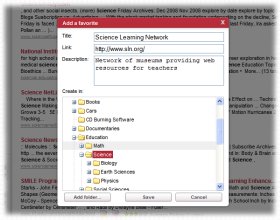|
Education
Web
Viewing 1-3 of 3 total results
readers, with information from our background questionnaire providing external validity for the preliminary five-class solution we present. Implications of Our Latent Class Analysis for Instruction Ultimately, the technique of latent class analyses of...
1
0
readers, with information from our background questionnaire providing external validity for the preliminary five-class solution we present. Implications of Our Latent Class Analysis for Instruction Ultimately, the technique of latent class analyses of adult reader profiles could be used by the adult education system to identify types of readers for instructional purposes, from beginners through GED levels. Simply knowing a reader’s score on a reading comprehension test does not usually give teachers
9
0
http://www.ncsall.net/fileadmin/resources/research/report_29_ials.pdf#page=9
www.ncsall.net/fileadmin/resources/research/report_29_ials.pdf#page=9
EXECUTIVE SUMMARY Background As its title indicates, this study’s aim was to understand the relationship <span class="highlight">of</span> the <span class="highlight">component</span> skills <span class="highlight">of</span> reading, such as word <span class="highlight">recognition</span>, vocabulary, and spelling, to large-scale measures <span class="highlight">of</span> literacy, such as the 1992 National Adult Literacy Survey (NALS) (Kirsch, Jungleblut, Jenkins, & Kolstad, 1993) and the closely related International Adult Literacy Survey (IALS) (Tuijnman, 2001). The NALS and IALS used real-world items such as advertisements, bus schedules
14
0
http://www.ncsall.net/fileadmin/resources/research/report_29_ials.pdf#page=14
www.ncsall.net/fileadmin/resources/research/report_29_ials.pdf#page=14
readers, with <span class="highlight">information</span> from our background questionnaire providing external validity <span class="highlight">for</span> the preliminary five-class solution we present. Implications <span class="highlight">of</span> Our Latent Class <span class="highlight">Analysis</span> <span class="highlight">for</span> Instruction Ultimately, the technique <span class="highlight">of</span> latent class analyses <span class="highlight">of</span> adult reader profiles could be used by the adult education system to identify types <span class="highlight">of</span> readers <span class="highlight">for</span> instructional purposes, from beginners through GED levels. Simply knowing a reader’s score on a reading comprehension test does not usually give teachers
45
0
http://www.ncsall.net/fileadmin/resources/research/report_29_ials.pdf#page=45
www.ncsall.net/fileadmin/resources/research/report_29_ials.pdf#page=45
CONCLUSIONS Implications <span class="highlight">of</span> “Tipping Points” <span class="highlight">for</span> Instruction We have made a beginning at identifying “tipping points” in print and vocabulary abilities by noting that, at the .85 proficiency level, those abilities coincide with the onset <span class="highlight">of</span> IALS Level 3 literacy skills, with all that Level 3 performance implies <span class="highlight">for</span> improved quality <span class="highlight">of</span> life opportunities. Our latent class <span class="highlight">analysis</span> supported this finding when it created Class 1, which is made up <span class="highlight">of</span> people distributed on either side <span class="highlight">of</span> the IALS Levels
46
0
http://www.ncsall.net/fileadmin/resources/research/report_29_ials.pdf#page=46
www.ncsall.net/fileadmin/resources/research/report_29_ials.pdf#page=46
approaches work best <span class="highlight">for</span> these “tipping point” students. Fortunately, several <span class="highlight">of</span> the adult literacy studies currently underway and funded by National Institute <span class="highlight">of</span> Child Health and Human Development and the Institute <span class="highlight">of</span> Education Sciences are exploring this and other questions related to best practice in reading instruction <span class="highlight">for</span> these adult intermediate readers. The Relationship <span class="highlight">of</span> the <span class="highlight">Component</span> Skills to Comprehension This research indicates that the components <span class="highlight">of</span> vocabulary and word <span class="highlight">recognition</span> have the same
47
0
http://www.ncsall.net/fileadmin/resources/research/report_29_ials.pdf#page=47
www.ncsall.net/fileadmin/resources/research/report_29_ials.pdf#page=47
reported very limited English abilities. Implications <span class="highlight">of</span> Our Latent Class <span class="highlight">Analysis</span> <span class="highlight">for</span> Instruction Ultimately, the technique <span class="highlight">of</span> latent class analyses <span class="highlight">of</span> adult reader profiles could be used by the adult education system to identify different types <span class="highlight">of</span> readers <span class="highlight">for</span> instructional purposes, from beginners through GED levels. University and hospital reading clinics have been using this reading profile approach <span class="highlight">for</span> many years (Chall, 1994; Chall and Curtis, 1990). As our <span class="highlight">analysis</span> suggests, patterns <span class="highlight">of</span> strengths
NCSALL Reports #19 August 2001 Even Start Site 235 It explores how the context of the Even Start family literacy program, for the majority of the students, provided a community of confirmation and recognition supporting these students’ efforts of self...
1
0
NCSALL Reports #19 August 2001 Even Start Site 235 It explores how the context of the Even Start family literacy program, for the majority of the students, provided a community of confirmation and recognition supporting these students’ efforts of self- definition and movement toward their goals for themselves and their children. But this chapter is also the story about the challenges these students face, both within the
7
0
http://www.ncsall.net/fileadmin/resources/research/19_c5.pdf#page=7
www.ncsall.net/fileadmin/resources/research/19_c5.pdf#page=7
NCSALL Reports #19 August 2001 Even Start Site 235 It explores how the context <span class="highlight">of</span> the Even Start family literacy program, <span class="highlight">for</span> the majority <span class="highlight">of</span> the students, provided a community <span class="highlight">of</span> confirmation and <span class="highlight">recognition</span> supporting these students’ efforts <span class="highlight">of</span> self- definition and movement toward their goals <span class="highlight">for</span> themselves and their children. But this chapter is also the story about the challenges these students <span class="highlight">face</span>, both within the
reasonable inferences about effectiveness from patterns of findings while taking research limitations into account. The analysis was qualitative in orientation. Although it was hypothetically possible to conduct a quantitative meta-analysis for some outcome variables&md...
1
0
reasonable inferences about effectiveness from patterns of findings while taking research limitations into account. The analysis was qualitative in orientation. Although it was hypothetically possible to conduct a quantitative meta-analysis for some outcome variables—tested learning gain, for example—it was determined that valid data from a sufficient number of studies did not exist. Furthermore, statistical information critical for a quantitative meta- analysis was generally not reported for the existing studies
13
0
http://www.ncsall.net/fileadmin/resources/research/report6.pdf#page=13
www.ncsall.net/fileadmin/resources/research/report6.pdf#page=13
reasonable inferences about effectiveness from patterns <span class="highlight">of</span> findings while taking research limitations into account. The <span class="highlight">analysis</span> was qualitative in orientation. Although it was hypothetically possible to conduct a quantitative meta-<span class="highlight">analysis</span> <span class="highlight">for</span> some outcome variables—tested learning gain, <span class="highlight">for</span> example—it was determined that valid data from a sufficient number <span class="highlight">of</span> studies did not exist. Furthermore, statistical <span class="highlight">information</span> critical <span class="highlight">for</span> a quantitative meta- <span class="highlight">analysis</span> was generally not reported <span class="highlight">for</span> the existing studies
|
